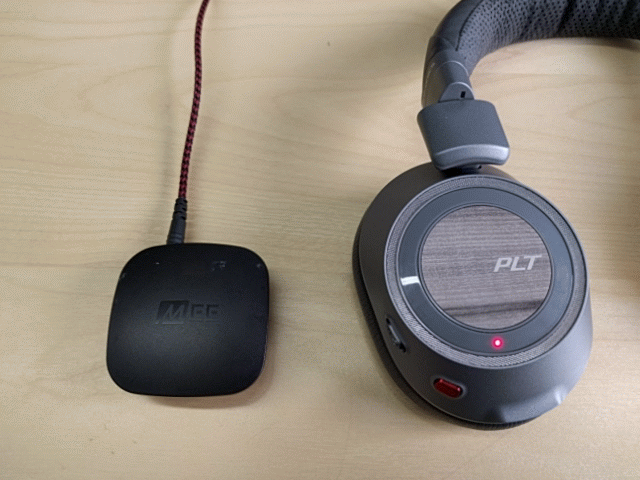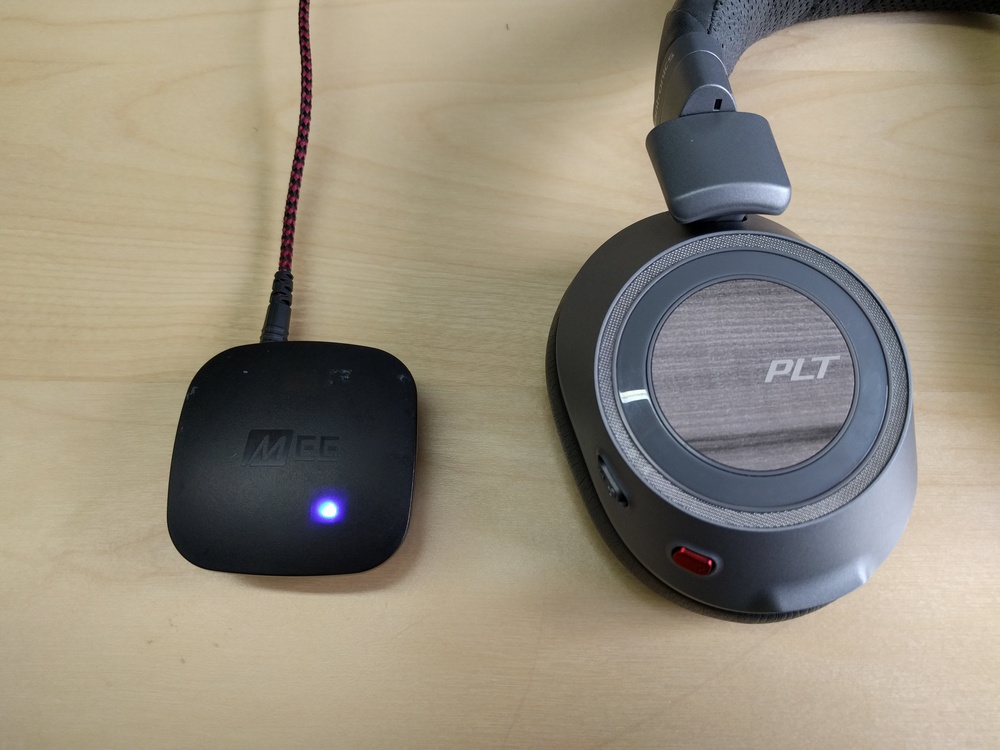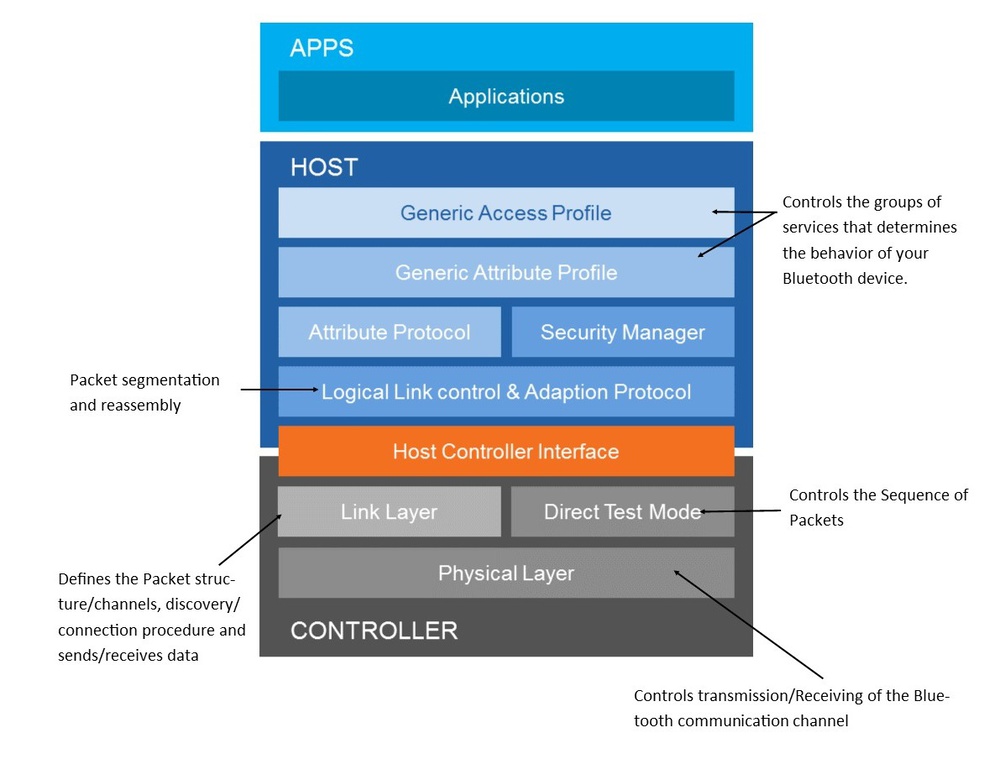Bluetooth is a short-range wireless technology that allows devices to exchange data over the air instead of using cables. Originally designed as a way to unite devices (its name comes from the Danish king Harald Bluetooth, known for uniting disparate Scandinavian tribes into a single kingdom), the format has flourished. Bluetooth is now a ubiquitous method for wirelessly connecting phones, headphones, computers, and more. Over the years, the protocol has improved, and new features have been added. In this article, we'll explain what Bluetooth is and how it works, run through its version history, explain what Bluetooth profiles are, and give you a guided tour of the Bluetooth audio codecs you're likely to run into as a headphone user.
How Does Bluetooth Work?
Bluetooth creates a short-range wireless link between devices using low-power radio waves. Pairing is the process of creating this link, during which the devices exchange security keys. Once paired, devices can reconnect securely without going through the pairing process each time they're switched on.
 |
 |
Bluetooth rapidly switches between 79 channels in the 2.4GHz band to avoid interference in crowded radio environments, changing about 1600 times per second. The two devices follow a shared frequency-hopping pattern and stay synchronized by matching both the timing and sequence. If interference or obstacles like walls or your body disrupt the signal, Bluetooth automatically retries or adjusts the connection to keep the link stable.

How to use Bluetooth
Despite the technical complexity, using Bluetooth with headphones is simple: you put both the primary device (like your phone or computer) and the secondary device (like your headphones or speaker) into pairing mode. The primary device scans for nearby devices. Once you see the secondary device pop up, click it and follow any relevant instructions. Once they're connected, boom: audio or data can be sent wirelessly between the devices. Where you were once tethered to wires as an audio listener, Bluetooth brings a wireless dawn.
Bluetooth Versions
A Bluetooth version refers to the particular iteration of the Bluetooth standard that a device supports. The Bluetooth Special Interest Group (SIG) updates the standard over time, improving aspects like speed, range, and energy efficiency. Newer versions are usually backward-compatible. That means Bluetooth 5.0 headphones can still connect to a phone with Bluetooth 4.2, for example, but the connection will only use features common to both. It's important to note that the version number is mostly about the wireless capabilities (range, data rate, power usage) and underlying features, not directly about audio quality or the types of audio formats. When it comes to Bluetooth, audio quality is more affected by codecs (which we'll get into further down).
Here's a quick summary to explain the commonly encountered Bluetooth versions and the major differences between each grade:
| Version | Year | Max Speed | Range | Low Energy Support | Key Features Introduced | Usage Notes |
|---|---|---|---|---|---|---|
| 1.0/1.1 | 1999-2001 | 721Kbps | ~10 m | No | Initial release, basic pairing, mono headsets (HSP/HFP only), now obsolete without backward compatibility | Obsolete. Major interoperability issues. Not backward compatible with later versions. |
| 1.2 | 2003 | 721Kbps | ~10 m | No | Adaptive Frequency Hopping, A2DP support begins, now obsolete without backwards compatibility | Obsolete. Improved stability, but still not backward compatible with modern Bluetooth devices. |
| 2.0 | 2004 | 2.1Mbps | ~10 m | No | Enhanced Data Rate (EDR), improved power efficiency | Obsolete. First to introduce EDR. Still found in some older accessories and car systems. |
| 2.1 | 2007 | 2.1Mbps | ~10 m | No | Secure Simple Pairing (SSP), better standby power | Mostly obsolete. SSP introduced, improving security. Some legacy devices may still support this. |
| 3.0 | 2009 | 24Mbps (Wi-Fi offload) | ~10 m | No | Optional Wi-Fi data burst | Obsolete. High Speed (HS) rarely adopted. Primarily a transitional step, not used in audio gear. |
| 4.0 | 2010 | 1Mbps (BLE) | ~50 m (BLE) | Yes | Bluetooth Low Energy (BLE) introduced; slow advertising masking | Common in early BLE fitness trackers and smart devices. Rarely seen in current audio products. |
| 4.1 | 2013 | 1Mbps (BLE) | ~50 m | Yes | Better LTE coexistence, multiple role support; slow advertising masking | Some basic wireless headphones and fitness wearables still use this. Lacks newer features. |
| 4.2 | 2014 | 1Mbps (BLE) | ~50 m | Yes | Increased data packet size for BLE, IPv6 over BLE; slow advertising masking | Widely supported. Used in many mid-range headphones. Foundation for modern BLE coexistence. |
| 5.0 | 2016 | 2Mbps (BLE) | Up to 240 m (line-of-sight) | Yes | 2x BLE speed, 4x range, 8x broadcast capacity; slow advertising masking | Mainstream. Used in most current Bluetooth headphones. Enables multipoint and dual audio. |
| 5.1 | 2019 | 2Mbps (BLE) | Up to 240 m | Yes | Direction finding (AoA/AoD), enhanced ATT; slow advertising masking | Appearing in newer devices. Supports direction finding and better connection handling. |
| 5.2 | 2020 | 2Mbps (BLE) | Up to 240 m | Yes | LE Isochronous Channels, LC3 codec, LE Audio; slow advertising masking | Used in LE Audio-ready gear. Not yet widely adopted, but enables next-gen features like Auracast. |
| 5.3 | 2021 | 2Mbps (BLE) | Up to 240 m | Yes | Lower latency idle switching, channel classification; slow advertising masking | Emerging. Further BLE enhancements. Found in latest generation of flagship headphones. |
| 5.4 | 2023 | 2Mbps (BLE) | Up to 240 m | Yes | Electronic shelf label support, extended advertising; slow advertising masking | Cutting edge. Adopted in select 2023–2024 devices. Still rare in most consumer audio gear. |
To sum up that table, newer versions of Bluetooth tend to have better range, more stability against interference, lower energy usage, and support for the latest features. If you're shopping for headphones and see Bluetooth 5.0 versus 5.2, it means both will work with modern phones, but the 5.2 headphones have the hardware to use newer features like LE Audio or Auracast, which allows audio to be broadcast to multiple nearby devices simultaneously, which can make setting up speakers for a garden party much easier! Still, it's probably not worth stressing too much about Bluetooth versions when it comes to headphones, but if you're set on future-proofing your devices, it's good to know.
Bluetooth Profiles: How Devices Know What To Do
A Bluetooth profile defines what connected devices can do over a Bluetooth link. Profiles are closely related to the specific feature sets that each device supports. For example, playing audio, transferring files, using a keyboard, or connecting to a smartwatch each use a different profile. When two Bluetooth devices connect, they exchange information about what profiles each supports, and they'll only use the ones they have in common. In the context of headphones and audio, the important profiles to know are:
A2DP (Advanced Audio Distribution Profile): This profile handles stereo audio streaming from your phone to Bluetooth headphones or speakers. If you're listening to music or any media audio, A2DP is what's in use. It's designed for one-way transmission (from source to receiver) and doesn't carry microphone audio. All modern Bluetooth headphones and earbuds support A2DP, and it's often referred to as the core Bluetooth audio profile.
AVRCP (Audio/Video Remote Control Profile): This profile lets your headphones control playback on the source device. When you press play, pause, skip tracks, or adjust the volume using your headphones, AVRCP sends those commands. It also supports metadata like song titles and artist names on compatible devices. AVRCP is usually paired with A2DP on stereo headphones to complete the media playback experience.
HSP (Headset Profile) and HFP (Hands-Free Profile): These profiles manage phone call audio and two-way voice communication. HSP is the older, simpler version, while HFP adds more features and better compatibility with modern smartphones. HFP handles both incoming audio from the phone and outgoing audio from your headphones' microphone. It's used during phone calls, video calls, or voice assistants. Most stereo headphones today switch from A2DP to HFP automatically during a call, which is why music pauses when you answer the phone. Audio quality in HFP is limited, typically using lossy narrow-band codecs that are well-suited for the vocal range of the human voice.

What LE Audio Enables
LE Audio doesn't just offer new codecs like LC3 (which you'll read more about below); it also introduces new profiles and protocols that open up broader accessibility and device functionality. For instance, TMAP (Telephony and Media Audio Profile) standardizes how devices like hearing aids and earbuds handle calls and media in parallel. HAP (Hearing Access Profile) is built specifically for hearing aids, supporting Auracast integration, multi-stream audio, and public broadcast audio. These features aren't so essential for headphone users to know about, but they're part of the benefits offered by Bluetooth version 5.2 and above.
Bluetooth Codecs
When streaming audio over Bluetooth, the sound isn't sent as raw, uncompressed data—it's compressed to fit within the bandwidth limits of a Bluetooth connection. This is where codecs come in. A Bluetooth codec is an algorithm that compresses audio on the source device (like your phone) and decompresses it on the receiving device (like your headphones).
Two key factors come into play here: bitrate, which is the amount of audio data sent per second, and latency, which is the delay between when the audio is sent and when you hear it. Latency can be especially important when watching videos, as high values can lead to lip-sync issues, although different apps and devices compensate for latency in different ways.
In an ideal world, we'd want high-quality audio delivered quickly and reliably, even in a noisy wireless environment. Unfortunately, these goals can conflict: higher quality usually means a higher bitrate, which can increase latency or risk connection dropouts. On the other hand, more compression will result in less data being transmitted, which can help make the connection rock-solid and fast, but at the expense of the audio quality.
Different codecs use different strategies to strike a balance between bitrate and latency, as this table shows:
| Codec | Max Bitrate | Latency | Platform Support | Max Sample Rate / Bit Depth | Pros | Cons |
|---|---|---|---|---|---|---|
| SBC | ~328Kbps | 150–200 ms | Universal | 16-bit/48kHz | Mandatory, compatible with all Bluetooth devices | High latency, variable quality |
| AAC | ~256Kbps | 120–150 ms | Apple, Android | 16-bit/48kHz | Optimized for iOS | Inconsistent on Android |
| aptX | 352Kbps | 150–170 ms | Android, Windows | 16-bit/48kHz | Lower latency than SBC | Not supported by Apple devices |
| aptX HD | 576Kbps | 200–300 ms | Android | 24-bit/48kHz | High-resolution audio support, improved detail over base aptX | High latency and battery use |
| aptX LL | 352Kbps | 30–40 ms | Android, PC | 16-bit/48kHz | Low latency | Limited support, requires compatible transmitter and receiver |
| aptX Adaptive | ~420Kbps (adaptive) | 80–100 ms (low-latency mode) | Android (Snapdragon) | 24-bit/48kHz | Dynamically adjusts bitrate and latency, good all-rounder, versatile | Needs recent hardware |
| aptX Lossless | 1Mbps | >100 ms | Snapdragon Sound | 16-bit or 24-bit/44.1kHz | True lossless wireless audio under optimal conditions | Rare, high bandwidth |
| LDAC | 990Kbps | 200–300 ms | Android | 24-bit/96kHz | Hi-res potential, flexible bitrate modes, widely available on Android | High latency, prone to dropouts at high bitrates, not available on iOS |
| LC3/LC3+ | 345Kbps | <50 ms (target) | Bluetooth 5.2+ (LE Audio) | 32-bit float/48kHz | High latency, prone to dropouts at high bitrates, not available on iOS | Not widely adopted yet |
| LHDC | 900Kbps | 100–150 ms | Android (select OEMs) | 24-bit/96kHz | High-resolution audio (up to 24-bit/96kHz), Hi-Res Wireless certified | Limited device support, not available on iOS, variable performance |
| Samsung Scalable (SSC) | ~512Kbps (adaptive) | Variable | Samsung devices only | 24-bit/96kHz | Adaptive bitrate for stable connection, supports 24-bit audio, optimized for Galaxy Buds and Samsung phones | Proprietary, not available on non-Samsung devices |
A word about sample rate and bit depth
While bitrate and latency are the factors that will have the biggest impact on the real-world usability of a codec, to fully understand how a codec performs, you'll also want to consider its sampling rate (how many times per second the audio is measured, like 44.1kHz or 48kHz) and bit depth (how much information is captured in each sample, like 16-bit or 24-bit). These two factors influence the dynamic range, resolution, and overall fidelity of the sound. In short, sampling rate and bit depth determine the potential ceiling of audio quality. The best-performing codecs carefully balance bitrate, latency, sampling rate, and bit depth.
As the table shows, different codecs support different sample rates and bit depths. That said, when it comes to Bluetooth, they don't tell the whole story. Even if a codec supports 24-bit/96kHz audio, the actual stream may be resampled, reduced, or adjusted depending on your app and device's settings and connection stability. For example, LDAC can support 24-bit/96kHz, but it might reduce the bitrate if the connection weakens. Apps like Spotify will do this automatically, especially if your settings are prioritizing low data usage. Moreover, the source itself is often compressed (for example, an MP3 uploaded to YouTube), so all the extra bandwidth provided by codecs like LDAC isn't being used. So, while these numbers help define the ceiling of what a codec can handle, they don't guarantee what you're actually hearing. And again, whether you'll be able to meaningfully notice any difference in audio quality between a 16-bit/48kHz signal and a 24-bit/96kHz is up for debate.
How do you pick a Bluetooth codec?
Your devices will usually pick a Bluetooth codec for you. When you pair headphones to your phone or computer, both devices negotiate and automatically select the best codec they both support. If your headphones support aptX but your phone doesn't, they'll fall back to a shared option like SBC. On most Android phones, you can check or change the codec in the developer settings. And if your headphones support a couple of different codecs, you can often choose which one you prefer in their companion app. But when it comes to iPhones and iPads, you're stuck with AAC, with SBC as a fallback option when AAC is unsupported. So even if your headphones advertise support for aptX or LDAC, they won't use those on iOS devices.
Conclusion
Bluetooth has come a long way, evolving from a basic wireless link into a powerful, flexible standard that can connect all kinds of devices. Newer Bluetooth versions have brought us better range, connection stability, and support for features like multipoint pairing or LE Audio. But don't get hung up on version numbers and profiles. Bluetooth versions are backward compatible, so your older devices still work fine. And while Bluetooth codecs like LDAC promise increased audio quality because of their higher max bitrate, the jury's still out on whether this is noticeable in most listening environments. It's certainly worth paying attention to Bluetooth version numbers and codecs, but don't get hung up on them.
Audio quality depends on many things, not least headphone design. A poorly tuned pair of headphones with LDAC can sound worse than a well-optimized model using basic SBC. Bluetooth is one part of the puzzle when buying headphones, but factors like frequency response and battery life will likely have more impact on your day-to-day experience using a pair. It's always worth checking out some detailed reviews before shelling out on a new pair of headphones. And hey, if you're in the market for a new pair, check our recommendations for the best Bluetooth headphones.
Recent Updates
07/07/2025: We rewrote this article to provide more up-to-date information for our readers.
